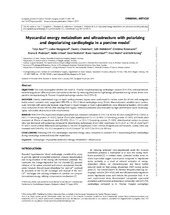| dc.contributor.author | Aass, Terje | en_US |
| dc.contributor.author | Stangeland, Lodve | en_US |
| dc.contributor.author | Chambers, David J. | en_US |
| dc.contributor.author | Hallstrõm, Seth | en_US |
| dc.contributor.author | Rossmann, Christine | en_US |
| dc.contributor.author | Podesser, Bruno K. | en_US |
| dc.contributor.author | Urban, Malte | en_US |
| dc.contributor.author | Nesheim, Knut | en_US |
| dc.contributor.author | Haaverstad, Rune | en_US |
| dc.contributor.author | Matre, Knut | en_US |
| dc.contributor.author | Grong, Ketil | en_US |
| dc.date.accessioned | 2020-06-09T08:29:49Z | |
| dc.date.available | 2020-06-09T08:29:49Z | |
| dc.date.issued | 2017-03-02 | |
| dc.Published | Aass T, Stangeland L, Chambers DJ, Hallstrõm S, Rossmann C, Podesser BK, Urban M, Nesheim, Haaverstad R, Matre K, Grong K. Myocardial energy metabolism and ultrastructure with polarizing and depolarizing cardioplegia in a porcine model . European Journal of Cardio-Thoracic Surgery. 2017;52(1):180-188. | eng |
| dc.identifier.issn | 1010-7940 | |
| dc.identifier.issn | 1873-734X | |
| dc.identifier.uri | https://hdl.handle.net/1956/22511 | |
| dc.description.abstract | OBJECTIVES: This study investigated whether the novel St. Thomas’ Hospital polarizing cardioplegic solution (STH-POL) with esmolol/adenosine/magnesium offers improved myocardial protection by reducing demands for high-energy phosphates during cardiac arrest compared to the depolarizing St. Thomas’ Hospital cardioplegic solution No 2 (STH-2). METHODS: Twenty anaesthetised pigs on tepid cardiopulmonary bypass were randomized to cardiac arrest for 60 min with antegrade freshly mixed, repeated, cold, oxygenated STH-POL or STH-2 blood cardioplegia every 20 min. Haemodynamic variables were continuously recorded. Left ventricular biopsies, snap-frozen in liquid nitrogen or fixed in glutaraldehyde, were obtained at Baseline, 58 min after cross-clamp and 20 and 180 min after weaning from bypass. Adenine nucleotides were evaluated by high-performance liquid chromatography, myocardial ultrastructure with morphometry. RESULTS: With STH-POL myocardial creatine phosphate was increased compared to STH-2 at 58 min of cross-clamp [59.9 ± 6.4 (SEM) vs 44.5 ± 7.4 nmol/mg protein; P < 0.025], and at 20 min after reperfusion (61.0 ± 6.7 vs 49.0 ± 5.5 nmol/mg protein; P < 0.05), ATP levels were increased at 20 min of reperfusion with STH-POL (35.4 ± 1.1 vs 32.4 ± 1.2 nmol/mg protein; P < 0.05). Mitochondrial surface-to-volume ratio was decreased with polarizing compared to depolarizing cardioplegia 20 min after reperfusion (6.74 ± 0.14 vs 7.46 ± 0.13 µm2/µm3; P = 0.047). None of these differences were present at 180 min of reperfusion. From 150 min of reperfusion and onwards, cardiac index was increased with STH-POL; 4.8 ± 0.2 compared to 4.0 ± 0.2 l/min/m2 (P = 0.011) for STH-2 at 180 min. CONCLUSIONS: Polarizing STH-POL cardioplegia improved energy status compared to standard STH-2 depolarizing blood cardioplegia during cardioplegic arrest and early after reperfusion. | en_US |
| dc.language.iso | eng | eng |
| dc.publisher | Oxford University Press | eng |
| dc.rights | Attribution Non-Commercial (CC BY NC) 4.0 | eng |
| dc.rights.uri | https://creativecommons.org/licenses/by-nc/4.0/ | eng |
| dc.subject | Cardioplegia | eng |
| dc.subject | Myocardial protection | eng |
| dc.subject | Energy metabolism | eng |
| dc.subject | Ultrastructure | eng |
| dc.title | Myocardial energy metabolism and ultrastructure with polarizing and depolarizing cardioplegia in a porcine model | en_US |
| dc.type | Peer reviewed | |
| dc.type | Journal article | |
| dc.date.updated | 2019-12-06T09:40:05Z | |
| dc.description.version | publishedVersion | en_US |
| dc.rights.holder | Copyright 2017 The Authors | |
| dc.identifier.doi | https://doi.org/10.1093/ejcts/ezx035 | |
| dc.identifier.cristin | 1456022 | |
| dc.source.journal | European Journal of Cardio-Thoracic Surgery | |

